Having the correct heating controls is essential for an efficient heating system. Clever use of controls can help you minimise energy consumption by ensuring each room is at the right temperature for comfort, while avoiding overheating.
With the help from articles from Which, The Energy Saving Trust and OFTEC we take a look at the key elements of a good heating system.
Boiler controls
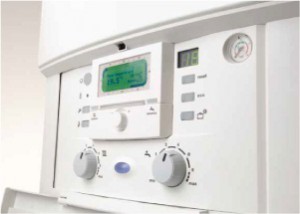
A full range of built-in boiler controls, including on/off switch, heating and hot water temperature controls and a timer.
Boiler on/off switch
The simplest boiler control is the on/off switch. Turning it on puts the boiler in standby mode until it needs to provide heat for your hot water or radiators. Some on/off switches have an option to turn on the heating and hot water, or just the hot water, so you can turn the heating off permanently during summer.
Temperature controls
Some boilers have separate controls for the temperature of the heating and hot water.
This allows you to set the temperature that the water leaves the boiler to supply the heating – handy if you want to try to ensure that your boiler operates as efficiently as possible (by lowering the temperature), or make it heat the radiators more quickly in cold weather (by increasing the temperature).
Tips:
- Set your boiler temperature to 82°C in winter (between medium and hot) and adjust down if radiators feel too hot, or up if not warm enough.
- Set your boiler temperature to 65°C in summer (between medium and low) and adjust down if water feels too hot.
Being able to control the hot water temperature can be helpful for families with children, who might want to prevent scalding hot water from reaching their taps. It can also provide a boost if cold weather means your hot water is not quite hot enough.
Mechanical boiler timers
A mechanical timer turns your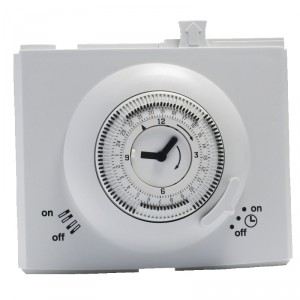 boiler on and off at the times you select with sliding tabs
boiler on and off at the times you select with sliding tabs
A simple mechanical timer allows you to turn the boiler on and off at set times
Mechanical timers are simple to set, but your boiler always turns on and off at the same time each day, so may not suit you if you have different weekday and weekend routines.
Digital boiler timers and programmers
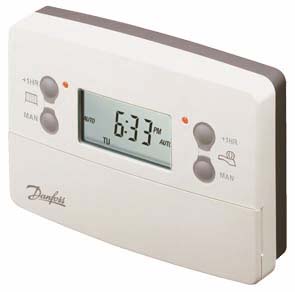 The electronic timer or programmer decides when the boiler is able to run. It is not true that boilers work best when they are running continuously or that energy is saved by leaving the heating on all day, even if the home is unoccupied.
The electronic timer or programmer decides when the boiler is able to run. It is not true that boilers work best when they are running continuously or that energy is saved by leaving the heating on all day, even if the home is unoccupied.
Whenever the boiler is firing it is using energy, and whenever the home is being heated to a temperature above that outside, it will be losing heat to the outside world. In spring and autumn there is no need to keep the heating on all day; a reasonably well insulated home can be left to cool down slowly with the heating timed to come on perhaps an hour or so before people return home from work.
A seven day timer is also strongly recommended, so that it is possible to set a different heating pattern for weekdays and weekends. Some timers allow different patterns for each day of the week; this can be useful for those working part-time or on shifts that vary from the conventional Monday-Friday work pattern
Central heating controls
These are positioned away from your boiler and usually allow you to turn it on or off to regulate the temperature in your home. Older versions are connected by wires running to your boiler, newer systems tend to send signals to the boiler wirelessly.
Room thermostat
 A room thermostat switches the heating system on and off as necessary.
A room thermostat switches the heating system on and off as necessary.
It works by sensing the air temperature, switching on the heating when the air temperature falls below the thermostat setting, and switching it off when the temperature is reached.
Tips:
- Setting the thermostat to 20°C is usually adequate.
- Recommended night-time temperature is 16-19°C.
- It is advisable for babies to sleep in a room of 18°C.
- The temperature shouldn’t drop bellow 16°C for elderly people and those with impaired mobility.
There’s usually only one room thermostat per heating system which controls the temperature of the whole house based on the temperature of the room it is sited in. It is best located in a living room which you’ll probably want to be the warmest room in the house.
Room thermostats need a free flow of air to sense the temperature, so they must not be covered by curtains or blocked by furniture. Nearby electric fires, televisions, wall or table lamps may stop the thermostat from working properly.
Programmable room thermostat
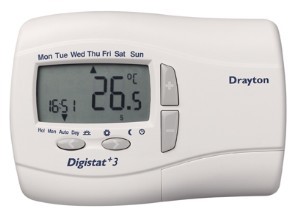 A programmable room thermostat lets you choose what times you want the heating to be on, and what temperature it should reach while it’s on.
A programmable room thermostat lets you choose what times you want the heating to be on, and what temperature it should reach while it’s on.
A seven-day timer makes it possible to set a different heating pattern for weekdays and weekends. Some timers allow different patterns for each day of the week; this can be useful for people working part-time or on shifts.
If your heating system is a boiler with radiators, there will usually be only one programmable room thermostat to control the whole house.
The time on the programmer must be correct. Some types have to be adjusted in spring and autumn when the clocks go forward and back.
You may be able to temporarily adjust the heating programme, common options are:
- ‘party’ which turns the heating on for a few hours
- ‘override’ lets you temporarily change the pre-programmed temperature during one of the programmed periods
- ‘holiday’ which turns the heating of for a set number of days
Thermostatic radiator control valves (TRVs)Programmable room thermostats need a free flow of air to sense the temperature, so they must not be covered by curtains or blocked by furniture. Nearby electric fires, televisions, wall or table lamps
may prevent the thermostat from working properly.
Thermostatic radiator control valves (TRVs)
 A thermostatic radiator valve lets you control the temperature of your room by changing the flow of hot water through your radiator. These detect the local air temperature and regulate the flow of hot water through the radiator, depending on how hot the room is. They do not control the boiler.
A thermostatic radiator valve lets you control the temperature of your room by changing the flow of hot water through your radiator. These detect the local air temperature and regulate the flow of hot water through the radiator, depending on how hot the room is. They do not control the boiler.
They should be set to give you the temperature that you want in each individual room, and allow you to set different temperatures for each room that you have them in.
It’s not a good idea to have a TRV on the radiator in the same room as the main thermostat as, if you alter the TRV, the thermostat will adjust itself to be in line with this local radiator.
They usually have a fat valve at one end, marked with a * and numbers from one to five. The * setting is to protect against frost.
TVRs need a free flow of air around them and should not be covered by curtains or blocked by furniture.
Hot water controls – Cylinder thermostat
 A cylinder thermostat switches on and off the heat supply from the boiler to the hot-water cylinder. It works by sensing the temperature of the water inside the cylinder, switching on the water heating when the temperature falls below the thermostat setting, and switching it off once this set temperature has been reached.
A cylinder thermostat switches on and off the heat supply from the boiler to the hot-water cylinder. It works by sensing the temperature of the water inside the cylinder, switching on the water heating when the temperature falls below the thermostat setting, and switching it off once this set temperature has been reached.This thermostat is strapped to the outside of a hot water cylinder near the bottom. It should be set to between 60°C and 65°C, which is high enough to kill of harmful bacteria in the water, but not so high that it increases the risk of scalding.
If you have a boiler control thermostat, it should always be set to a higher temperature than that of the cylinder thermostat so it can produce water that is hot enough to heat the water in the cylinder.
Wireless controls and Intelligent heating systems
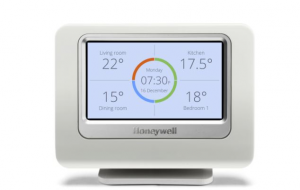 A new breed of thermostat and heating control is now available for the home – one that will allow for the busy modern life; varying temperatures between the outside and inside; variability between rooms and some will even learn about your habits to!
A new breed of thermostat and heating control is now available for the home – one that will allow for the busy modern life; varying temperatures between the outside and inside; variability between rooms and some will even learn about your habits to!
We will pick up on this growing trend in a future post.
Thanks Gerry, great article.
Our smart thermostat, the HUB Controller, will do all that and more.
We can monitor usage a burn rates and inform people when they are about to run out of oil!